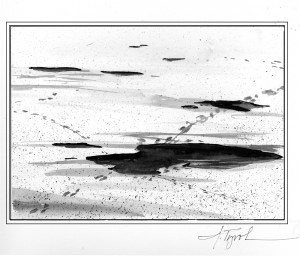
In the spring of 1984, I spent many days in a study carrel on the seventh floor of Baker Library at Dartmouth College while writing Pond and Brook. One day, I walked past nearby Occom Pond and was stunned to see the ice melting and the shore littered with hundreds of fish - bloated, sallow bodies sporting eyes clouded with death. Over the next few days I was repeatedly asked, “What killed all of those fish at Occom Pond?”
“In some winters, the oxygen level in the water becomes so low that fish can suffocate,” I replied.
“But why doesn’t that happen every year?” came the inevitable follow-up.
When a pond freezes over, it becomes sealed off from the normal exchange of gases between air and water. Oxygen above the ice cannot mix into the water, and carbon dioxide from the respiration of animals becomes trapped below. Meanwhile, gases released by decomposers accumulate near the bottom of the pond, including carbon dioxide, hydrogen sulfide, and ammonia.
Some aquatic plants, including microscopic ones like algae, continue to use whatever sunlight passes through the ice for photosynthesis, releasing oxygen and absorbing carbon dioxide in the process. But as ice thickens and becomes covered with snow, less light penetrates and less oxygen is produced. The productive “water weed” Elodea, for example, typically produces only half the oxygen in winter that it does during mid-summer.
In short, when ice forms early in the winter and stays late, especially when it is covered by snow, oxygen levels can fall so drastically, especially in shallow ponds, that fish begin to die off.
Paradoxically, the coating of ice also protects pond life from the extremes of winter weather. Although some plants and insects overwinter as dormant seeds or eggs, much pond life continues on as usual throughout the winter, only at a slower pace that requires less food and oxygen. The temperature of water under the ice, and that of a cold-blooded animal that lives there, hovers just above freezing. In Life in the Cold, author Peter Marchand observes that, for every 10°C drop in water temperature, a cold-blooded animal’s metabolic rate is cut in half.
Minnows remain sluggishly active, as do red-spotted newts, tadpoles, and crayfish. Free-swimming carnivorous insects are on the prowl, including whirligig beetles, predaceous diving beetles, and aquatic bugs called backswimmers. These insects employ tiny bubbles and silvery films of air as minute aqualungs into which oxygen diffuses from the surrounding water.
Cut a hole in the ice, scoop up some mud, and you’ll catch the same, gill-equipped immature stages of insects that you would find in summer, such as mayflies, caddisflies, dragonflies, and damselflies. Many insects continue burrowing down as the mud along the edge of the pond freezes deeper. Some, such as mayflies and caddisflies, can even survive freezing.
Muskrats often emerge from where they huddle in dome-shaped winter lodges of mud-packed cattails. The level of oxygen-carrying hemoglobin increases in their blood in winter, enabling longer dives under the ice where they forage on submerged stems and roots. Beavers snuggle to preserve body heat. When hungry, they leave the lodge by an underwater entryway and swim a short distance to where their cache of branches has been laid up for winter, having been cut and pushed into the mud during the fall. These robust aquatic rodents also rely on autumn stores of body fat to survive. In winter, a diving beaver’s pulse rate drops so low that it can remain submerged for fifteen minutes.
Cold-blooded animals take the diving beaver’s strategy to the extreme by dramatically decreasing their heartbeat, circulation, metabolism, and growth. Bluegills enter a state of aquatic suspended animation while still remaining buoyant. Frogs, salamanders, and turtles dig into the mud in search of oxygen-rich seeps. Garter snakes sometimes hibernate in crayfish burrows at the pond’s edge. Snakes occasionally share the same hibernacula with frogs and salamanders; animals which, in autumn, were the snake’s erstwhile prey. Snapping and painted turtles also hibernate near the edge of the pond.
Dormant turtles may absorb some oxygen directly through the surface of their exposed skin. As lactic acid accumulates in their bloodstream, chemical buffers - calcium, magnesium and potassium - become more concentrated, neutralizing the acid. Despite numerous studies, scientists have yet to discover exactly how the normally air-breathing turtle survives being submerged all winter in reduced oxygen conditions.
Turtles will occasionally awaken under the ice. I recall the frigid, snowless early winter of 1975, when a thick layer of clear “black” ice formed over the ponds. As I ventured out onto the ice one day, eerily suspended above the living diorama, I saw a spotted turtle swim lazily by. That window into another world, that clear crystalline floor beneath my feet, was also a window to the turtle’s winter sky.

